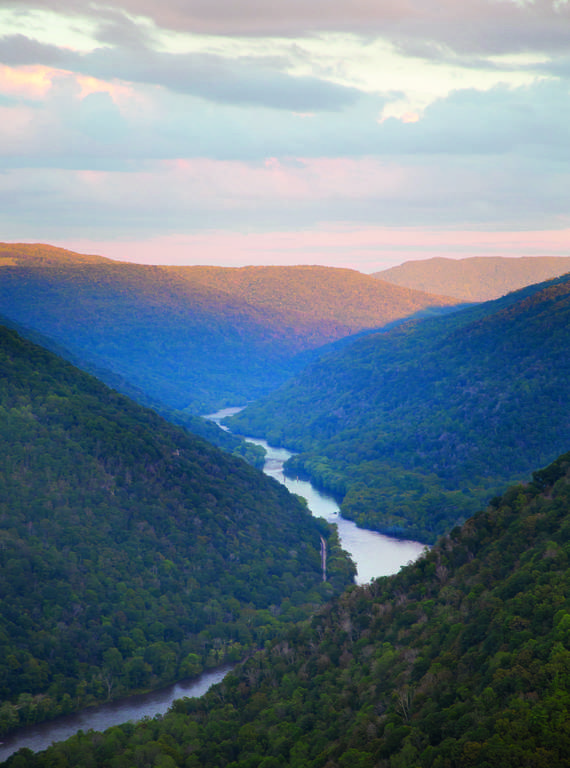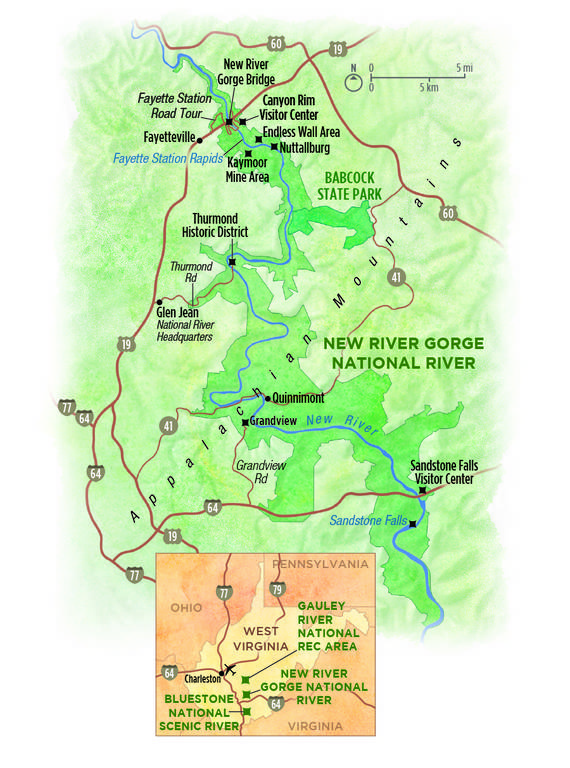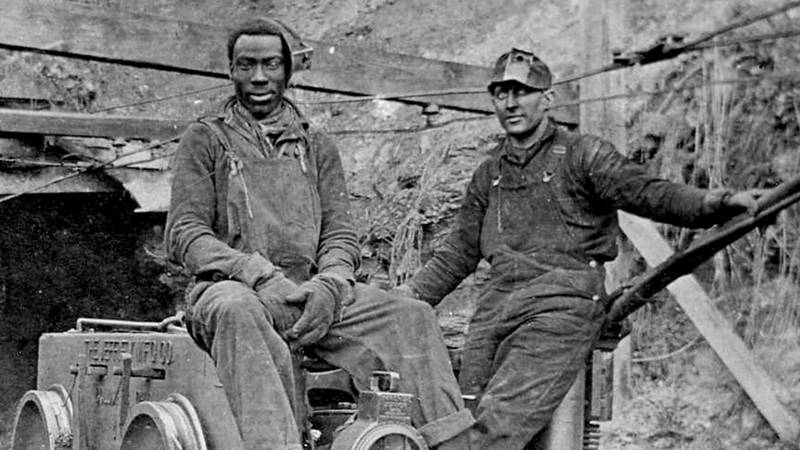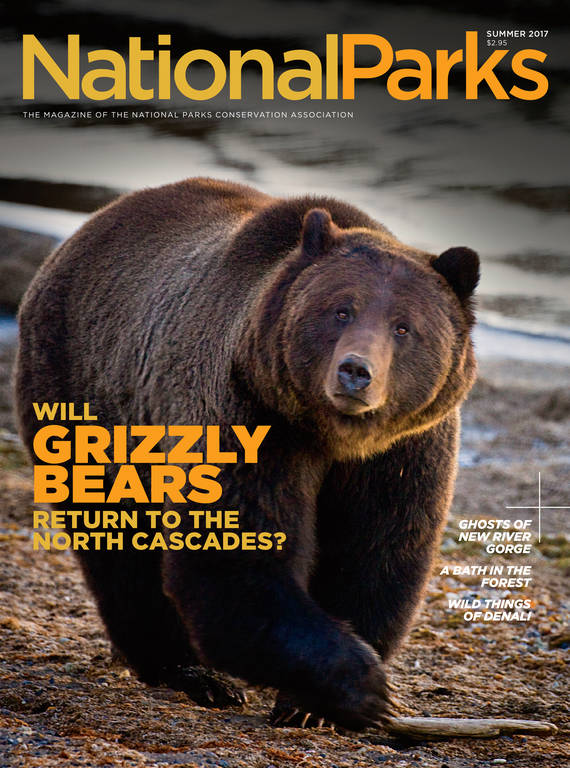Summer 2017
Ghosts of the Gorge
Coal, culture and the transformation of New River Gorge National River.
As you drive from Western Pennsylvania on I-79 into West Virginia, the ground begins to swell. Steep hills rise around you, great mounds of rock swathed in trees. Farmland sprawls in the gaps. The sky expands. Speeding along under wispy clouds in late August, I had a sense of being hugged by the land.

At Grandview, visitors get just that: an expansive view of the park, 53 miles of protected watercourse and forest snaking through the southern Appalachians.
© MEGGAN AND JEFF HALLERAfter four hectic days in my hometown of Pittsburgh, it felt good to be alone, heading to a place I’d never been: New River Gorge National River, 53 miles of protected watercourse and forest snaking through the southern Appalachians. I was excited for the epic vistas in the 70,000-acre park, but even more intrigued by the remnants of old mining towns along the river, whose slopes churned with activity from the late 1800s through the 1950s. Photos I’d seen of coal conveyers and coke ovens half-swallowed by brush reminded me of wrecked steel mills by the Monongahela River back home. I’ve always found it oddly beautiful, this blend of nature and Rust Belt decay. I wondered how mining had shaped the culture and the land.
Designated in 1978 in the wake of a grassroots effort to prevent dam-building, New River Gorge National River is part of a trifecta. Two other parks, Gauley River National Recreation Area and Bluestone National Scenic River, were established 10 years later and feature two other rivers in the region’s ancient watershed. Together the parks draw more than a million visitors annually. Beyond its natural and historic interest, the area is also a prime destination for rock climbers and whitewater boaters. When you add in mountain biking trails, zip lines and an event like “Bridge Day” — the October festival when thousands gather to watch BASE jumpers leap off the New River Gorge Bridge and parachute 876 feet down — the gorge looks like an adrenaline junkie’s paradise. Measuring 3,030 feet across, the bridge is one of the longest steel arch spans in the Western Hemisphere and the third-highest in the United States. With its completion in 1977, a winding 40-minute drive through the gorge was reduced to a minute-long trip.
I hadn’t come for extreme sports; I figured three days of hiking in the mountains would be intense enough. That morning I’d bought a new daypack and stuffed a cooler with hot dogs, peanut butter and jelly sandwiches, and several jugs of water to combat the 90-degree heat. I didn’t have a tent, but my dad had lent me his SUV, big enough for me to sleep in the back.

In 2016, visitation to New River Gorge and other national park sites in West Virginia increased by almost 5 percent in part because of a campaign by Visit Southern West Virginia to promote the national parks of the area. For more information go to visitwv.com.
© KAREN MINOTWhen I hit the stretch of U.S. 19 that runs along the park, it was late afternoon. I was eager to disappear into the woods, but I first wanted to get my bearings at Canyon Rim Visitor Center, which perches on a sandstone ledge and offers lofty views of the river and bridge.
Inside, a helpful ranger assessed my hiking plans. He drew X’s through a leg of the 8.6-mile Kaymoor Trail that had been washed out by recent flooding. For that evening, he recommended the Endless Wall Trail, a short hike favored by locals and climbers that zigzags along cliffs. Sold.
Off a country road — many of the park’s sites, I’d learn, are accessed via narrow back roads that bend around private homes and farms — I found Nuttall Trailhead, one end of the Endless Wall Trail. It had rained earlier, cutting the heat, and I happily sank into the coolness of the forest. Soon I crossed paths with a blond woman and a man with a blue bandana on his head, leaning on a walking stick.
“We just saw a bear!” he said. They both wore big, frazzled smiles. The bear had sprinted from the side of the cliff, crossing the trail right in front of them. “We’ve been coming here for years, and that’s never happened.” The man shook his head. “It was fast, boy!”
The American black bear, West Virginia’s state animal, is common in the region but rarely seen in daytime. The possibility of encountering one set my nerves humming, but after a few minutes, I eased back into a rhythm, my footsteps thumping on the springy trail. I could hear the river churn and, periodically, joyful whoops from kayakers and rafters far below.
At Diamond Point, the trail descends toward a creek, where mountain runoff feeds ferns, mosses and strange, leopard-spotted fungi. New River Gorge is part of the largest continuous deciduous forest in the world, with flora more diverse than almost anywhere in the central and southern Appalachians — around 1,400 species in all. Oaks, hickories and conifers abound. Giant rhododendrons reach overhead, making shady tunnels.
After doubling back, I sat on a ledge at the cliffs and let my leg dangle, trying not to imagine what falling would feel like. Around me, pines clung to blocky sandstone. Nearly 1,000 feet down, a blue raft drifted like a floating Tic Tac past my giant shoe.
WHEN I ROLLED INTO RIFRAFTERS CAMPGROUND, it was after 10 p.m. With summer winding down, people were scarce: just a handful of RVs and lit cabins. Randy Robertson, 64, owner of the camp, is chatty and charmingly frank. Sleeping in the car? He chuckled, then walked me out and shined a flashlight on a grassy patch under a tree: my spot for the next two nights. He said he’d charge me the tent rate, 15 bucks a day.
His father, he told me, had owned a small mine, but when demand for coal shrank in the 1950s, he “lost everything.” Still, Robertson also took up mining, working for New River Company. “I was 16 years underground,” he said. But the coal market bottomed out again in the mid-80s, and he lost his job. After failed attempts to start a body shop and salvage yard, he bought a plot of land and built his campground. He’s managed the place for 21 years. “West Virginia people are resilient,” he said. “We survive.”
Robertson sold me a bundle of wood, and I managed to get a fire going. I cracked a beer, speared a hot dog, let it blister in the flames. The first bite was so good I had to sit down.
IT WAS THE CHESAPEAKE AND OHIO RAILWAY THAT changed everything. When the C & O was completed and reached New River Gorge in 1873, a previously inaccessible wilderness was tapped. Suddenly the region’s high-carbon coal could be transported to Virginia and the Midwest. Investors swarmed, and company towns sprang up along the river — over 50 of them by the early 20th century.
The new jobs attracted thousands of Northern miners, Europeans and African American miners from the South. The work was backbreaking but equalizing: In the dark mines, with every man’s face smudged with coal dust, race and ethnicity counted for less. Yet, mine owners intentionally segregated company housing in an attempt to prevent unionizing, and black miners and their families often lived farther up the gorge.
Since the New River coal seams lay flat, like thin layers within a cake, mines were carved horizontally into the mountainside. Inside, labyrinths of pillared rooms could stretch back for miles. One of the most productive of these mines was Kaymoor, where from 1899 to 1962, miners unearthed almost 17 million tons of bituminous coal.
In the boom-and-bust coalfields, Kaymoor’s longevity was unusual. The life span of most company towns was around 25 years, at which point the coal seam was so far back in the mountain that it was more profitable to move on. In the first half of the 20th century, leaps in automation (along with a shift to strip mining, a decline in production after World War II and other factors) contributed to a steady decline in mining jobs. By the 1950s, 85 percent of West Virginia coal was cut and loaded with machines — and cases of black lung had spiked from increased coal dust created by the new machinery. Around the same time, the move from coal-powered steam to diesel locomotives hurt the industry. When mining families moved on, they left ghost towns behind.
About the Photographers
To get to Kaymoor, I started at the Arrowhead Trails, named for the Order of the Arrow, the Boy Scouts’ national honor society; over 1,000 volunteer scouts created the looped trails, which are designed for mountain biking, in 2011. At 9 a.m., it was already hot. The woods were calm, but the forest spiders had been busy. I caught web after web in the face, which was exasperating until it was funny. All day, I’d find little black-and-yellow arachnids rappelling from my clothes.
At the mine site I found the mine portal, eerily quiet, with a hand-painted board outside: “It Has Been ___ Days Without A Lost Time Accident.” Mining was, and is, dangerous work. Although there were no major explosions at Kaymoor — gases released in mines, called “damps,” can cause huge fireballs if ignited — accidents did happen. By 1940, at least 21 men had died in the mine from electrocutions, cave-ins or fires.
I tried to imagine the operation in its heyday: railcars heaped with coal coming out, and men with picks and explosives streaming in. After being weighed and inspected at the headhouse, coal was transported down the slope, by haulage car or conveyer, to the riverside, where it was loaded onto trains or processed into coke onsite. I poked around some gutted structures, where hunks of coal still litter the ground, then decided to check out the former town of Kaymoor Bottom, which requires walking down — and back up — 821 wooden steps. On the descent, I passed a woman in gym clothes, who smilingly told me it was her third time up the stairs that day.

Coal miners emerge from the Kaymoor Mine in a 1914 photograph.
NPSFor me, once was enough. I huffed up the Kaymoor Miners Trail, chugging water. Then after a quick snack, I headed out to another mine site. In 1870, John Nuttall began constructing Nuttallburg, one of the first towns to ship the region’s “smokeless” coal out of the gorge. At the base of a rocky path, the site’s main attraction is the headhouse and conveyer system built by Henry Ford. The automobile mogul leased the mine in the 1920s in an attempt at “vertical integration,” a plan to control every facet of the car manufacturing process.
Designed to move the fragile coal downhill with minimal breakage, the conveyer was cutting-edge technology in its time. A 1928 New York Times headline exulted, “FORD WORKS A MIRACLE IN MINING COAL,” though Ford’s experiment ended that same year despite impressive gains in efficiency and production. Unable to control the railroad that shipped coal to his steel mills, he gave up the mine, which changed hands several times before finally closing in 1958. Forty years later, the Nuttall family sold the property to the National Park Service; the long project of restoring the site was completed in 2011.
NPCA AT WORK
Outside the mine entrance, a cold draft stirred leaves and wildflowers. The temperature in the mines, I learned, is always 53 degrees — a comfortable climate for manual labor. The mine’s dimensions, however, were far from ideal. The Sewell coal seam at Nuttallburg was just 3.5 feet high, so miners had to work hunched or even lying down. Though the mines are now off-limits to visitors, they provide a crucial habitat for seven of the park’s 10 bat species, two of which are federally listed as endangered.
To reach the Nuttallburg town site, I took the Conveyor Trail, a series of slaggy, unkempt switchbacks descending toward the river. As I hacked through the overgrowth with a stick, Ford’s conveyer swooped overhead like an industrial tube slide. At the bottom, I watched a tawny deer wade through the foundation of an old house, now a pit of weeds.
Down on the defunct train tracks, I peered up into the belly of the tipple, a towering structure where coal was sized and sorted before being “tipped” into train cars. Farther along the riverside trail, I walked by a row of crumbling stone ovens, abandoned since the ’20s, where coal was cooked for long stretches to burn off impurities and make coke, which burns hotter than coal and was used to forge steel. Before heading back up the slope, I lingered inside the roofless walls of the company store, where residents bought everything from groceries to Christmas presents, then wandered through the reforested remains of a neighboring town whose name egged me on: Seldom Seen.
When I checked my phone’s pedometer at the campground later, it showed I’d walked 13 miles. The back end of an SUV is not exactly plush, but that night it felt like the Marriott.
TRAVEL ESSENTIALS
FAYETTEVILLE, A MAJOR HUB IN THE NEW RIVER GORGE area, is billed as “The Coolest Small Town.” It has a bike shop, a hipster sandwich joint, an old theater and an outdoorsy culture. Around the historic town center, you see a lot of kayaks strapped to car roofs. On the last day of my trip, I ate breakfast at Cathedral Cafe, a funky church-turned-diner, where my eggs were served by a woman who had sold me beers at the General Store the night before.
Just down the road is Long Point Trail, a short hike with a huge payoff. After 1.6 miles, you emerge from a wooded thicket onto a long finger of rock jutting into the gorge. Straight ahead, the famous bridge arches above the river like a steel halo. If you time it right, you can see tiny train cars groan along the still-functioning CSX Railway below, lugging coal from the state’s few active mines toward Norfolk, Virginia, to be shipped overseas.
A TRAINED ARCHAEOLOGIST, DAVE FUERST IS THE PARK’S cultural resource specialist: In short, he is responsible for chronicling and preserving the history of the site. Before joining the Park Service 16 years ago, he worked as a federal archaeologist for the Marines, Air Force, Army and Army Corps of Engineers. When I found him in his office at the park’s headquarters, he greeted me with a vigorous handshake. I told him about my adventures at Nuttallburg, and he laughed. “Nobody does the Conveyor Trail!”
Fuerst said of all the places he’s lived and worked, West Virginia is his favorite. Though he grew up in Ohio, he feels a kinship with Appalachian people. And like Robertson, he was quick to lament the region’s persistent poverty. “It’s a contrast: We have so much in terms of resources, and most people here don’t benefit from that.”
SIDE TRIP
This imbalance of power and wealth has always marked the West Virginia coalfields, but especially in the early 1900s, before unions gained leverage to demand fairer terms. “Miners were kind of like indentured servants,” Fuerst said. “Mine owners tried to divide and conquer.” He explained how workers were paid in “scrip,” company-issued credit valued in full only at the company store. Most miners rented housing from the owners, and rents could be raised at will, with costs automatically deducted from workers’ pay.
Along with work-related risks, day-to-day life could be dangerous, too. “The train coming through would shoot up sparks, and your house could burn down at any time — you just never knew,” he said.
But the insularity of mining towns also created tight-knit communities that could transcend prejudice. Fuerst said that women, who formed close bonds while the men were at work, could be persuasive agents of social change: “You could make a case that the United Mine Workers’ decision to accept blacks into the union had to do with interactions that black women had with white women and black women had with immigrant women. They probably said, ‘Well, these are my friends.’”
After saying goodbye to Fuerst, I drove toward the southern tip of the park to the Sandstone Falls overlook, my last stop on the trip. Standing on a low observation platform, I could see the waterfall far below, framed in a ragged window of trees. At 20 feet tall, it’s no Niagara, but with foamy pools swirling around small islands, it’s a striking sight on one of the world’s oldest rivers. I considered hiking closer to the falls, but it was getting late; I needed to head north.
On the highway later, I kept thinking about the drama of American industry. I thought about heat and rocks and fuel and how the land heals itself. I thought about what labor is worth. I drove too fast, wanting to get back and spend time with my family before flying out the next morning. But as I hurtled past big rigs hauling late-night cargo, downing coffee in the dark, the mountains still seemed close.
About the author
-
 Dorian Fox Contributor
Dorian Fox ContributorDorian Fox is a writer and freelance editor whose essays and articles have appeared in various literary journals and other publications. He lives in Boston and teaches creative writing courses through GrubStreet and Pioneer Valley Writers' Workshop. Find more about his work at dorianfox.com.



